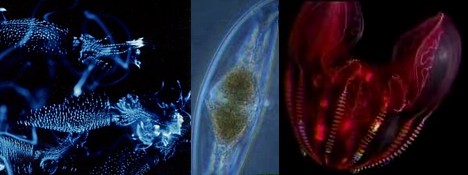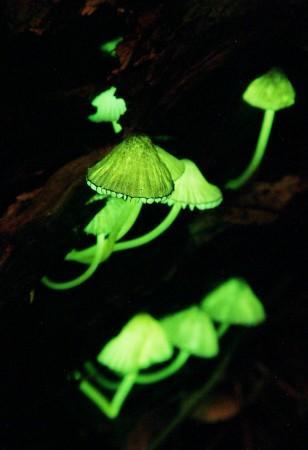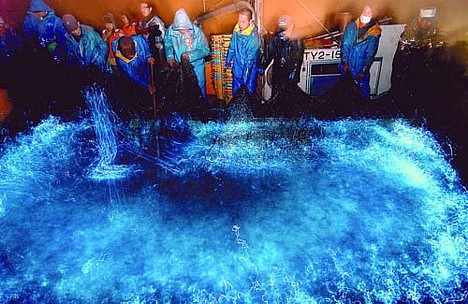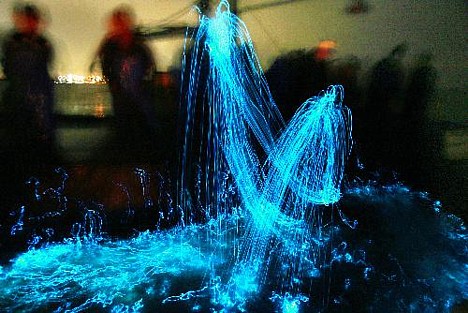This video presented by the Enoshima Aquarium shows the bioluminescent mantle of a flame scallop (Ctenoides ales, a.k.a. noble file clam or electric eye scallop), a bivalve mollusk found around reefs in shallow tropical waters. The purpose of the flashing lips remains a mystery.
Tag: ‘Bioluminescence’
Siphonophore: Deep-sea superorganism (video)
Here is some video of a bioluminescent deep-sea siphonophore -- an eerily fantastic creature that appears to be a single, large organism, but which is actually a colony of numerous individual jellyfish-like animals that behave and function together as a single entity. The individual units, called zooids, all share the same genetic material, and each performs a specialized role within the colony. The best-known siphonophore is the poisonous Portuguese Man o' War (Physalia physalis), which lives at the surface of the ocean, unlike the one shown in this video (filmed at a depth of 770 meters). Some siphonophore species can grow up to 40 meters (130 ft) in length.
Shrimp defense: glowing blue spit cloud (video)

Smooth nylon shrimp (Heterocarpus laevigatus) inhabiting the dark depths of the Pacific employ a brilliant method of defense. When threatened with attack, the creature spits a cloud of bioluminescent blue fluid from its mouth, temporarily blinding its predator and allowing escape.
This rarely seen footage of the smooth nylon shrimp's defense mechanism in action was shot at the Okinawa Churaumi Aquarium.
See also:
- Video: Tremoctopus defense mechanism
- Video: Three bioluminescent sea creatures
Video: Three bioluminescent sea creatures

This video clip from Japanese TV program "Best House 123" shows the top three glow-in-the-dark sea creatures selected by Hokkaido University professor Yoshihiro Omiya, a specialist in the study of bioluminescent organisms.
3. Firefly squid: This blue-glowing squid, Japan's most famous bioluminescent creature, measures 5 to 7 centimeters long and is often found at depths greater than 200 meters. In spring, when firefly squid rise to the surface to spawn en masse, they become Toyama's great tourist attraction and end up on dinner plates nationwide. One reason the firefly squid glows is to hide itself from predatory fish swimming below. When the squid lights up its bottom surface, fish looking up have a hard time seeing it because it blends with the sky above.
2. Bioluminescent plankton: Measuring 0.1 centimeter long and found in oceans around the world, this type of dinoflagellate glows blue when disturbed. Professor Omiya keeps a flask of the light-emitting plankton in his fridge, because just looking at the cool blue glow helps him relax when he's feeling stressed. While bioluminescent creatures are generally believed to emit light in order to intimidate their enemies, attract mates or defend themselves from predators, it is not entirely clear why this plankton glows.
1. Bioluminescent comb jelly: This 10 to 15 centimeter long gelatinous deep-sea creature, found at dark ocean depths of more than 200 meters, glows seven different colors in an otherworldly display of light. Many questions remain unanswered about why this comb jelly glows, making it a fantastic rainbow-colored mystery.
Rainy season brings glow-in-the-dark mushrooms
 With the arrival of Japan's rainy season, a mysterious type of green, glow-in-the-dark mushroom begins to sprout in Wakayama prefecture. The Mycena lux-coeli mushrooms, known locally as shii no tomobishi-dake (literally, "chinquapin glow mushrooms"), sprout from fallen chinquapin trees. As they grow, a chemical reaction involving luciferin (a light-emitting pigment contained within the mushrooms) occurs, causing them to glow a ghostly green.
With the arrival of Japan's rainy season, a mysterious type of green, glow-in-the-dark mushroom begins to sprout in Wakayama prefecture. The Mycena lux-coeli mushrooms, known locally as shii no tomobishi-dake (literally, "chinquapin glow mushrooms"), sprout from fallen chinquapin trees. As they grow, a chemical reaction involving luciferin (a light-emitting pigment contained within the mushrooms) occurs, causing them to glow a ghostly green.
The luminescent mushrooms were long believed to be indigenous solely to Tokyo's Hachijojima Island after they were discovered there in the early 1950s. In 1995, however, mycologists found the fungus growing wild in coastal areas of the southern Kii peninsula, as well as in Kyushu and other areas.
The mushrooms thrive in humid environments, popping up during Japan's rainy season, which typically lasts from the end of May to July. The caps can grow to as large as 2 cm (about 1 inch) in diameter, but because the mushrooms are prone to dehydration, they only have a few days to live once the rain stops.
[Source: Mainichi Shimbun]
Tourists bask in blue glow of firefly squid
Toyama Bay is the habitat of the world-famous glowing firefly squid, which surface in large numbers every spring in a phenomenon that has been designated a special natural monument. Peak firefly squid season means big catches for fishermen and brisk business for sightseeing boats that provide close-up views of the magical action.

Early in the morning, after 3 AM, sightseeing boats depart the Namerikawa fishing port (Namerikawa is also home to the world's only museum dedicated to the firefly squid) in Toyama prefecture, making a short journey to fixed nets located about 1 to 2 km offshore. As the fishermen haul in their nets, the light emitted by the firefly squid causes the sea surface to glow a cobalt blue, evoking squeals of delight from the tourists.

Toyama Bay's firefly squid fishing season opened on March 1 and is expected to continue until the end of June. Sightseeing boats are scheduled to run until May 7.
[Source: Yomiuri Shimbun, Asahi Shimbun]
The bioluminescent tail of Genji
Scientists have succeeded in unraveling the mystery -- at the protein structure level -- of the mechanism at work in the glowing tail of the "Genji firefly" (Luciola cruciata Motschulsky), which is considered to have the highest luminous efficiency of any known source of light. The results of the joint research carried by the Institute of Physical and Chemical Research (RIKEN) and Kyoto University are to be published in the March 16 edition of the British science journal Nature.

By tinkering with the chemical composition of luciferase (a bioluminescent enzyme), the research team succeeded in changing the emission color from its normal greenish-yellow to orange and red. Researchers are now attempting to recreate the blue glow of the sea firefly (Vargula hilgendorfii) and firefly squid (Watasenia scintillans) in order to have all three primary colors at their fingertips.
"This might prove useful in applications such as short-term emergency lighting when no source of electricity or combustion is available," says Kyoto University professor Hiroaki Kato. "Light could be created by mixing up a liquid protein solution."
Anytime energy is converted into light, there is some loss due to heat. Luminous efficiency is a measure of the proportion of energy supplied to a light source that is effectively converted into visible light energy (i.e. the amount not lost to heat or infrared radiation). The luminous efficiency of incandescent light bulbs is around 10%, while fluorescent light is around 20% and LED is around 30%. Firefly tails are significantly higher, at 90%. Scientists were aware that the Genji firefly used luciferase in combination with luciferin (a light-emitting substrate) and adenosine triphosphate (ATP) to produce light, but the detailed workings of the mechanism have until now remained a mystery.
[Sources: Jiji, RIKEN press release]
